|
CHAPTER XI.
INJECTORS.
ALTHOUGH the injector is not theoretically so efficient as
a good pump, practically it has proved itself the best means of
feeding water to locomotive boilers that has ever been tried.
When a well-made injector is used regularly, it is more reliable
than any form of pump, is more easily examined and repaired when
it gets out of order, is less liable to freeze or to sustain damage
from accidental causes, and it regulates the quantity of water
required as well as the ordinary pump, and better than any pump
actuated by the machinery of the engine, when the speed of a train
is irregular. The injector also possesses the important advantage
that it raises the temperature of the feed-water to approach the
temperature of the boiler, thereby avoiding shocks and strains
to metal that very cold water is likely to impart.
So long as injectors were imperfectly understood, and were
used with no regularity, they retained the name of being unreliable;
but so soon as they began to be made the sole feeding medium for
locomotive boilers, they had to be worked regularly, and kept
in order, which quickly made their merits recognized.
INVENTION OF THE INJECTOR.
The feed injector was invented by Henri Giffard, an
eminent French scientist and aeronaut. Its successful action was
discovered during a series of experiments, made with the view
of devising light machinery that might be used to propel balloons.
Although Giffard designed the most perfect balloon that was ever
constructed, the injector was not used upon it. and the invention
was laid aside and almost forgotten. During the course of a sea-voyage,
Giffard happened to meet Stewart of the engineering firm, Sharp,
Stewart & Co., of Manchester, England. In the course of a
conversation on the feeding of boilers, Giffard remembered his
injector, and mentioned its method of action. Stewart was struck
with the simplicity of the device, and undertook to bring it out
in England, which he shortly afterwards did, representing the
interests of the inventor so long as the original patents lasted.
By his advice, William Sellers & Co., of Philadelphia, were
given control of the American patents. Seldom has an invention
caused so much astonishment and wild speculation among mechanics,
and even among scientists, as the injector did for the first few
years of its use. Scientists were not long in discovering the
philosophy of the injector's action, but that knowledge spread
more slowly among mechanics. It was regarded as a case of perpetual
motion — the means of doing work without power, or, as Americans
expressed it, by the same means a man could raise himself by pulling
on his bootstraps.
PRINCIPLE OF THE INJECTOR'S ACTION.
Although the mechanism of the injector is very simple, the philosophy
of its action is not so easily understood as the principles on
which a pump raises water and forces it into the boiler. On beginning
to investigate the action of the injector, it appears a physical
paradox, the finding that steam at a given pressure leaves a boiler,
passes through several tortuous and contracted passages, raises
several check-valves, and then forces water into the boiler against
a pressure equal to that which the steam had when it first began
the operation. At first acquaintance the operation looks as if
it had a strong likeness to perpetual motion, but closer investigation
will show that the steam which raises and forces the water by
passing through an injector performs mechanical work as truly
as the steam that pushes a piston which moves a pump-plunger.
A current of any kind, be it steam, air, water, or other matter,
has a tendency to induce a movement in the same direction of any
body with which it comes in contact. Thus, we are all familiar
with the fact that a current of air called wind, passing over
the surface of a body of water, sets waves in motion, and dashes
the water high up on the shore away above its original level.
In the same way a jet of steam moving very rapidly, when injected
into a body of water, under favorable conditions, imparts a portion
of its motion to the water, and starts it with momentum sufficient
to overcome a pressure even higher than the original pressure
of the steam. The locomotive blast, blowers, steam siphons, steam
jets, jet exhausters, vacuum ejectors, and argand burners, are
all common instances of the application of the principle of induced
currents.
VELOCITY OF STEAM AND OF WATER.
At a boiler pressure of 140 pounds per square inch steam passes
into the atmosphere with a velocity of 1920 feet per second. When
steam at this speed strikes like a lightning-flash into the tubes
of the injector, it becomes the ram which forces the water towards
the boiler; but its power is opposed by the tendency of the water
inside the boiler to escape through the check-valve. The velocity
with which water will flow from a vessel is known to be equal
in feet to the square root of the pressure multiplied by 12.19.
Accordingly, in the case under consideration, the water inside
of the boiler would tend to escape at a speed of 144 feet per
second. This represents the resistance at the check-valve. The
mechanical problem, then, to be worked out by the injector is
to transform the energy of hot steam moving at a high velocity
into the momentum possessed by a heavier and colder mass of water.
In the operation the steam yields up a portion of its heat and
the greater part of its velocity, but it keeps a current of water
flowing fast enough to overcome the static resistance at the check-valve.
TEMPERATURE OF INJECTED WATER.
A common delivery temperature of the water forced through an injector
is 160 degrees Fahr. Taking the feed-water at 55 degrees Fahr.,
we find that the steam used in operating the injector imparts
105 degrees Fahr. to the feed-water before putting it into the
boiler. One pound of steam at 140 pounds boiler-pressure contains
1224 heat units reckoned above zero. When the hot steam speeding
at a high velocity strikes the feed-water, part of the heat is
converted into the mechanical work required to put the water in
motion, but there still is left heat sufficient to raise about
11 pounds of water to the temperature of 160 degrees. One pound
of steam, therefore, communicates to 11 pounds of water the motion
required for overcoming the resistance encountered at the. check-valve.
The steam moving at a speed of 1920 feet per second having imparted
motion to a body eleven times its own weight, itself in the mean
time having become a portion of the mass, the velocity of the
feed-water would be 1920 / 12 = 170 feet per second. When the
reduction of speed due to friction of the pipes and other resistances
is considered, there still remains momentum enough in the water
to raise the check-valve.
Although 160 degrees is about the average heat of the water
delivered by lifting injectors, instruments can be designed so
that they will heat the water much higher. With non-lifting injectors,
the feed-water is nearly always delivered at a higher temperature
than with the other kind.
ELEMENTARY FORM OF INJECTOR.
There are numerous forms of injectors in use, but they are all
developments of the elementary arrangement of parts shown in the
annexed illustration, Fig. 1. Steam at a high velocity passes
from the boiler into the tube A, and striking the feed-water
at B, is itself condensed, but imparts momentum to the
water to send it rushing along into the delivery pipe E
with sufficient force to raise the check-valve against the pressure
inside and pass into the boiler. As the current of water could
not be started into rapid motion against the constant pressure
of the check-valve, an overflow opening is provided in the injector,
through which the water can flow unchecked till the necessary
momentum is obtained, when the overflow valve is closed.
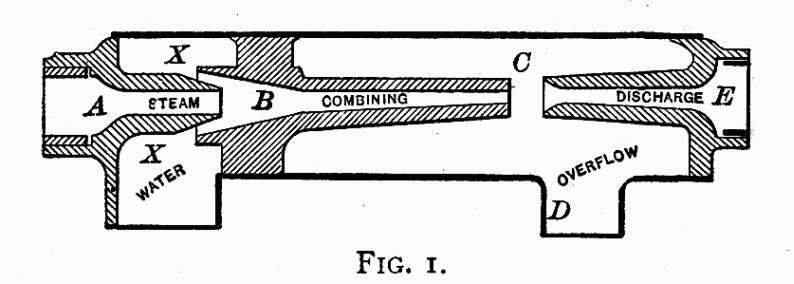
In a lifting injector, the parts are so designed that, in starting,
a jet of steam passes through the combining tube at sufficient
velocity to create a vacuum in the water-chamber XX, and
the water is drawn into this place from the feed-pipe as if by
the suction of a pump. The steam-jet then striking the water starts
it into motion. If too much steam is admitted for the quantity
of water passing, air will be drawn in through the overflow opening,
mixing with the water and reducing its compactness, while some
uncondensed steam will pass through with the water. This will
reduce the force of impact of the feed-water upon the boiler check,
and when it becomes so light that the momentum of feed-water is
no greater than the resistance inside the boiler, the injector
will break. On the other hand, when the quantity of water supplied
is too great for the steam to put into high motion, part will
escape through the overflow valve. In some forms of injectors,
separate appliances are used for raising the water from the forcing
chamber to the source of supply.
As the successful operating of the injector is dependent on
the feed-water promptly condensing the steam which supplies the
power, water of a very high temperature cannot be fed by an injector.
A certain amount of live steam must be condensed by the feed-water
to impart the momentum necessary to make the latter overcome the
resistance at the check-valve. When the feed-water becomes hotter
than 100 degrees Fahr. a point is soon reached where it takes
such a large body of water to condense the steam that there is
not the required velocity generated to force the feed water into
the boiler.
All deviations from the elementary form of injector shown are
made for the purpose of extending the action of the instrument
under varied conditions, for making it work automatically under
different pressures of steam, and for increasing its capacity
for raising the water to be used above its natural level.
CARE OF INJECTORS.
When an engineer finds that an injector refuses to work, his first
resort should be the strainer. That gets choked with cinders or
other impurities so frequently that no time should be lost in
examining it. One day when I was running a round-house, an engineer
came in breathless, with the information that his engine was blocked
in the yard, and he must dump his fire, as he could not get his
injector to work. The thermometer stood at twenty degrees below
zero, and an Iowa blizzard was blowing; so the prospect of a dead
engine in the yard meant some distressingly cold labor. I asked,
the first thing, if he had tried the strainer; and his answer
was that the strainer was all right, for the injector primed satisfactorily,
but broke every time he put on a head of steam. I went out to
the engine, and had the engineer try to work the injector. By
watching the overflow stream, I easily perceived that the injector
was not getting enough water, although it primed. An examination
showed that the strainer was full of cinders, and the injector
went to work all right as soon as the obstruction to the water
was removed.
THE MOST COMMON CAUSES OF DERANGEMENT.
Sand and cinders are the most common causes of failure with injectors,
as they are indeed with all water feeding apparatus. A very common
cause of failure of injectors is leakage of steam through throttle-valve
or check-valve, keeping the tubes so hot that no vacuum can be
formed to make it prime. A great many injector-checks have been
turned out too light for ordinary service, while others are made
in a shape that will always leave the valve away from the seat
when they stop working. Then the engineer has to run forward,
and pound the check with a hammer to keep the steam from blowing
back, and that soon ruins the casting. Check-valves set in a horizontal
position are worthless with water that contains grit.
HOW TO KEEP AN INJECTOR IN GOOD ORDER.
To preserve a good working injector, the engineer should see that
the pipes and joints are always perfectly tight. Of course it
is difficult to keep them tight when they are subjected to the
continual jars a locomotive must stand; but injectors cannot be
depended on where there is a possibility of air mixing with the
water. Leaky joints or pipes are particularly troublesome to lifting
injectors; for air passes in, and keeps the steam-jet from forming
a vacuum. At first the injector will merely be difficult to start;
but as the leaks get worse there will be no starting it at all.
Then, the air mixing with the water is detrimental to the working
of all injectors, as its tendency is to decrease the speed of
the water. The compact molecules of water form a cohesive body,
which the steam can strike upon with telling force to keep it
in motion. When the water is mixed with air it lacks the element
of compactness, and the steam-jet strikes a semi-elastic body
which does not receive momentum readily. This mixture of steam
and air does not act solidly on the check-valve, but makes the
water pass in with a bubbling sound, as if the valve were moving
up and down; and the stream of water breaks very readily when
it is working in this way.
COMMON DEFECTS.
As maintaining unbroken speed on the water put in motion is the
first essential in keeping an injector in good working order,
anything that has a tendency to reduce that speed will jeopardize
its action. A variety of influences combine to reduce the original
efficiency of an injector. Those with fixed nozzles are constructed
with the orifices of a certain size, and in the proportion to
each other which experiment has demonstrated to be best for feeding
with the varied steam-pressures. When these orifices become enlarged
by wear the injector will work badly, and nothing will remedy
the defect but new tubes. The tubes sometimes get loose inside
the shell of the injector, and drop down out of line. The water
will then strike against the side of the next tube, or on some
point out of the true line, scattering it into spray which contains
no energy to force itself into the boiler. A machinist examining
a defective injector should always make sure that the tubes are
not loose. Injectors suffering from incrusted water-passages will
generally work best with the steam low. In districts where the
feed-water is heavily charged with lime salts, it is common for
injectors to get so incrusted that the passages are almost closed.
Joints about injectors that are kept tight by packing must
be closely watched. Many an injector that failed to work satisfactorily
has been entirely cured by packing the ram-gland.
CARE OF INJECTORS IN WINTER.
During severe frosty weather an injector can be kept in order
much easier than a pump; but it needs constant watching and intelligent
supervision.
To keep an injector clear of danger from frost, it should be
fitted with frost-cocks so that all the pipes can be thoroughly
drained. Bends in the pipes, where water could stand, should be
avoided as far as possible; and where they cannot be avoided,
the lowest point should contain a drain-cock.
To operate an injector successfully, thoughtful care is requisite
on the part of the engineer; and where this is given, the injector
will prove itself a very economical boiler-feeder.
The injectors principally used in American locomotives are
the Sellers, the Nathan, the Mack, and the Rue Little Giant. All
are good reliable boiler-feeders, and all are made to wear well
under the rough service met with on locomotives.
THE SELLERS INJECTOR.
When the Giffard injector was first introduced into this country
by William Sellers & Co., Philadelphia, it was a rather defective
boiler-feeder; but that firm effected great improvements and led
the way for making the injector the popular boiler-feeder it is
to-day. They made the instrument self-adjusting, and improved
its design so that it would feed automatically, however much the
pressure of the boiler varied, and, finally they perfected it
so that, should anything happen to interrupt its working, it would
automatically restart itself. The latest development of the injector
is shown by a sectional view in Fig. 2.
This instrument will start at the lowest steam pressures with
water flowing to it, and will lift the water promptly even when
the suction-pipe is hot. At 10 pounds steam pressure it will lift
the Water 2 feet; at 30 pounds, 5 feet; and at all ordinary pressures,
say 60 pounds and over, it will lift from 12 to 18 feet. It can
be used as a heater for the water supply by simply closing the
waste-valve and pulling out the steam-lever.
By reference to the cut it will be seen that this injector
consists of a case A provided with a steam inlet B,
a water-inlet C, an outlet D through which the water
is conveyed to the boiler, an overflow opening E, a lever
F by which to admit steam, stop and start its working,
a hand-wheel G to regulate the supply of water, and an
eccentric lever H to close the waste-valve when it is desired
to make a heater of the injector.
Its operation is as follows:
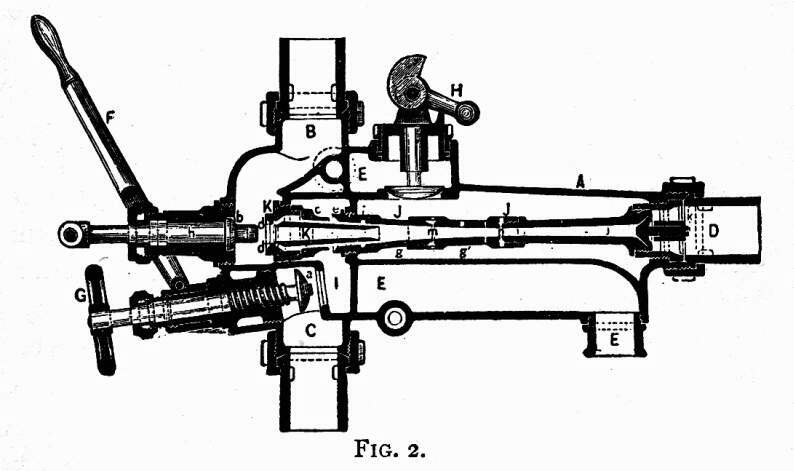
The water-inlet C being in communication with water
supply, the valve a is open to allow the water to enter
the chamber I, Steam is admitted to the chamber B,
and the lever F is drawn out to lift the valve b
from its seat and permit the steam to enter the annular lifting
steam-nozzle c through the holes d d. The steam issuing
from this nozzle passes through the annular combining tube e
and escapes from the instrument partly through the overflow opening
f and partly through the overflow openings provided in
the combining tube g g, through the overflow chamber J
and passage E E, and produces a strong vacuum in the water
chamber I which lifts the water from the source of supply,
and the united jet of steam and water is, by reason of its velocity,
discharged into the rear of the receiving end of the combining
tube g. The further movement of the lever F withdraws
the spindle h until the steam-plug i is out of the
forcing nozzle K, allowing the steam to pass through the
forcing nozzle K and come in contact with the annular jet
of water which is flowing into the combining tube around the nozzle
K. This jet of water has already a considerable velocity,
and the forcing steam jet imparts to it the necessary increment
of velocity to enable it to enter the boiler through the delivery
tube j and boiler check k.
If from any cause the jet should be broken—say from a
failure in the water supply—the steam issuing from the forcing
nozzle K into the combining tube g will escape through
the overflows m and n and intermediate openings
with such freedom that the steam, which will return through the
annular space formed between the nozzle K and combining
tube g, and escape into the overflow chamber through the
opening f, will not have sufficient volume or force to
interfere with the free discharge of the steam, issuing from the
annular lifting steam-nozzle and escaping through the same overflow
F, and hence the lifting steam-jet will always tend to
produce a vacuum in the water-chamber I, which will again
lift the water when the supply is renewed, and the combined annular
jet of steam and water will be forced into the combining tube
g against the feeble current of steam returning, when the
jet will again be formed and will enter the boiler as before.
In actual practice on a locomotive the movement of the lever F
in starting the injector is continuous.
NATHAN MFG. CO.'S IMPROVED MONITOR INJECTOR.
One of the most successful and enduring injectors in use is the
Monitor, the distinguishing feature of which originally was that
the injector is constructed with fixed nozzles, that insure great
durability, combined with certainty of action. The injector shown
in Fig. 3 is an improvement on the old Monitor, the radical change
being that this injector is operated by a single lever. Any one
who has studied the operation of the injector already described
will have no difficulty in perceiving how the new Monitor works.
It will be seen that steam is admitted from the top to the tube
that forms the body of the injector, and the water from below.
To start the injector, the water-valve W is opened. The
main lever S is then pulled out a short distance to lift
the water; when the water begins to escape through the overflow
the lever S is steadily drawn back, which puts the injector
working at its maximum power. The quantity of feed required is
graduated by the valve W.
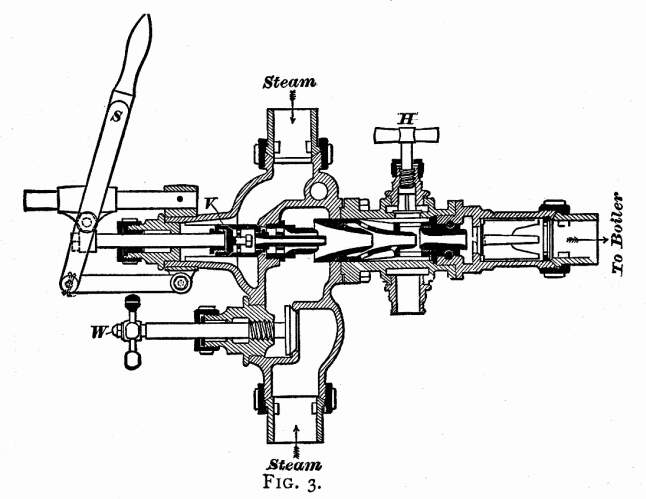
When it is desired to use the injector as a heater, close the
valve H and. pull out the lever S all the way. At
other times the valve H must be kept open.
With a boiler pressure of 30 pounds this injector will lift
the water 5 feet, and at ordinary working pressure the steam will
have power to lift the water to a height not likely to arise in
locomotive practice.
THE MACK INJECTOR.
The engraving gives a sectional view of the well known Mack injector,
which is one of the oldest and has long been a favorite on many
roads. The parts are strikingly simple, and they are designed
in very compact form. The section shows the arrangement very clearly.
The cone and tubes can be easily re-moved for cleaning; or should
they get cut by the sand in gritty water, or filled with incrustation,
they can betaken out and replaced by a new set in a few minutes,
the interchangeable parts being kept in stock. There is but one
water-passage and it is very large, so that there is very little
danger of sand or mineral deposits interfering with the efficiency
of the injector.
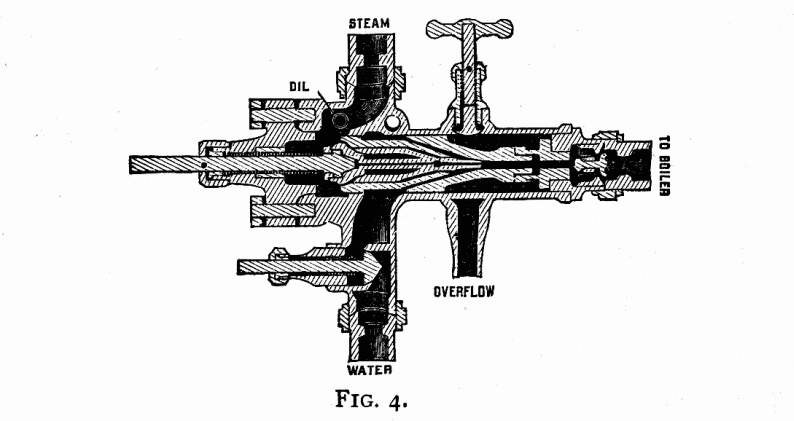
To work this injector, the steam-valve is opened one quarter
of a turn to lift the water; when water begins to escape from
the overflow, the steam-valve is opened till the water ceases
to pass out of the overflow opening. The supply is regulated by
the lazy-cock.
A special claim made for this injector is the wide range of
its delivery. The supply can be regulated to the absolute requirements
of the boiler, be the train fast or slow, light or heavy. It will
start readily at 30 pounds pressure and work up to any pressure
required. Below 50 pounds pressure it may be necessary to partly
close the supply of water.
LITTLE GIANT INJECTOR.
This injector, made by the Rue Manufacturing Co. is a highly efficient
boiler-feeder, and a very simple apparatus. The construction is
clearly seen in the engraving. A unique feature about this injector
is the movable combining tube adjusted by a lever, causing the
feed to be exactly suited to the service. Moving the lever towards
A tends to cut off the feed, and moving towards B
increases it.
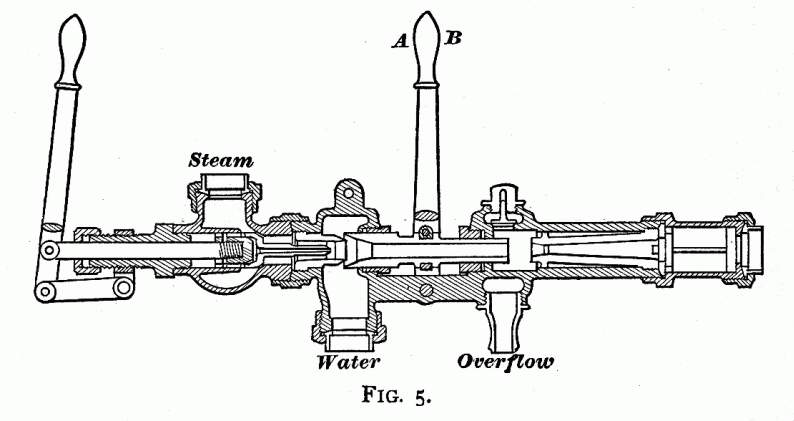
To work the injector, the combining tube lever is set in position
to admit sufficient water to condense the steam from the starting
valve. The starting valve is then opened slightly till the water
begins to escape from the overflow, when it is opened full. The
feed is then regulated by the combining tube lever. To use this
injector as a heater, the overflow is closed by the combining
tube being moved up against the discharge, and opening the starting
valve sufficiently to admit the quantity of steam required.
Table of Contents
| Contents Page
|







